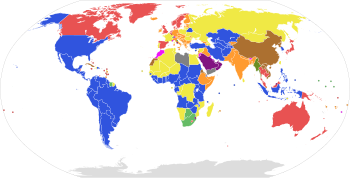
Semi-presidential republic
System of government in which a president exists alongside a prime minister and a cabinet / From Wikipedia, the free encyclopedia
A semi-presidential republic, or dual executive republic, is a republic in which a president exists alongside a prime minister and a cabinet, with the latter two being responsible to the legislature of the state. It differs from a parliamentary republic in that it has a popularly elected head of state; and from the presidential system in that the cabinet, although named by the president, is responsible to the legislature, which may force the cabinet to resign through a motion of no confidence.[1][2][3][4]

-
Map legend
1 This map was compiled according to the Wikipedia list of countries by system of government. See there for sources.Full presidential republics2 Semi-presidential republics2 Republics with an executive president or directory elected by or nominated by the legislature that may or may not be subject to parliamentary confidence Parliamentary republics2 Parliamentary constitutional monarchies where royalty does not hold significant power Parliamentary constitutional monarchies which have a separate head of government but where royalty holds significant executive and/or legislative power Absolute monarchies One-party states Countries where constitutional provisions for government have been suspended (e.g. military juntas) Countries that do not fit any of the above systems (e.g. provisional governments/unclear political situations) Overseas possessions, colonies, and places without governments
2 This map presents only the de jure form of government, and not the de facto degree of democracy. Some countries which are de jure republics are de facto authoritarian regimes. For a measure of the degree of democracy in countries around the world, see the Democracy Index or V-Dem Democracy indices.
| Part of the Politics series |
| Politics |
|---|
|
Government branches |
|
|
| Part of the Politics series on |
| Executive government |
|---|
| Head of state |
| Government |
|
| Systems |
| Lists |
| Politics portal |
While the Weimar Republic (1919–1933) and Finland (from 1919 to 2000) exemplified early semi-presidential systems, the term "semi-presidential" was first introduced in 1959 in an article by journalist Hubert Beuve-Méry,[5] and popularized by a 1978 work written by political scientist Maurice Duverger,[6] both of whom intended to describe the French Fifth Republic (established in 1958).[1][2][3][4]